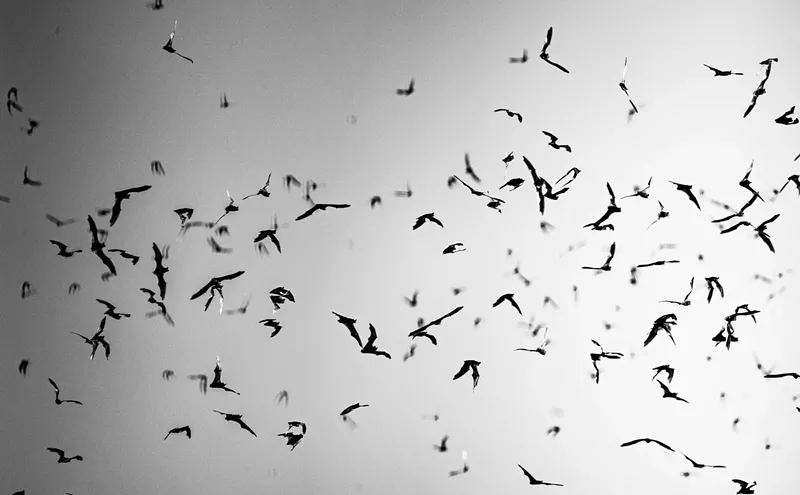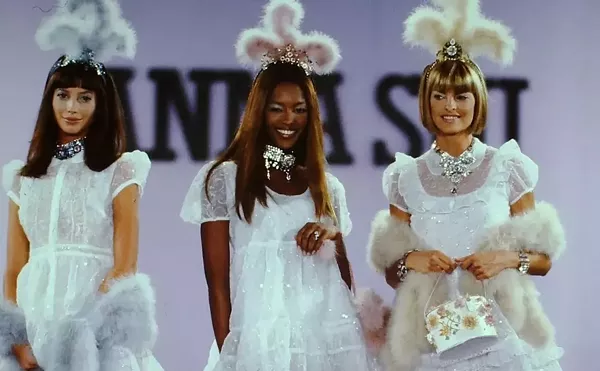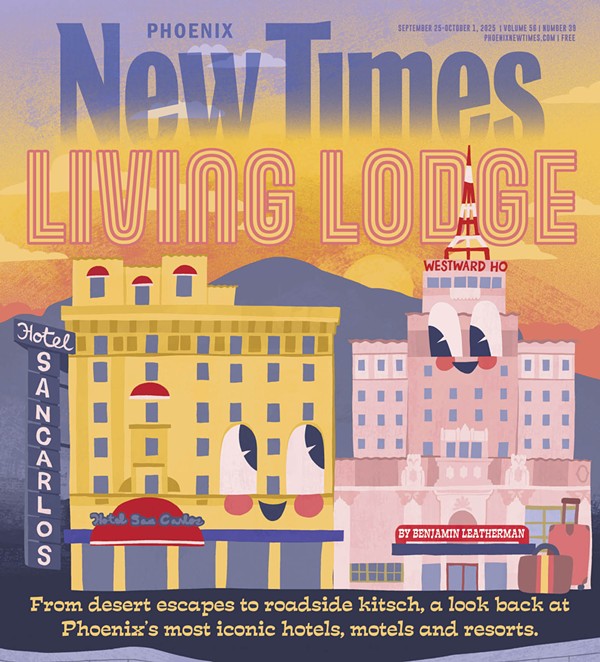The show features clothing, jewelry and fabrics by NUNO, a Japanese textile house directed by designer Reiko Sudo, and showcases the work of celebrated fabric designer Junichi Arai. NUNO fabrics have appeared since the 1970s on the runways of Rei Kawakubo, Yohji Yamamoto and Issey Miyake. However, only recently has NUNO work shown up in Western museums like the Victoria and Albert in London and the Cooper-Hewitt and the American Craft Museum in New York.
Though there are actual clothes included, with lines as clean and elegant as a Shinto temple, the fabrics themselves steal the show. As in the Japanese kimono, where the fabric and not the standardized shape is the expressive element, NUNO relies both on tradition and the latest technology to produce its unusual fabrics. Many techniques were devised by Arai, who has received 36 patents for his textile inventions.
And, as gallery director Louise Roman explained, though the fabrics look handwoven and one-of-a-kind, they are made on a computer-driven loom. "NUNO is primarily interested in experimentation," she said. "Arai comes up with an idea, produces it, and, when that run of fabric is finished, it is over. The fabrics are limited that way."
Some of the fabrics in the show are more suitable to gallery display than to sartorial use, which is indicative of the blurry area between fine art and functional craft in which NUNO dwells. It would be a shame, for example, to disrupt the flowing lengths of Arai's black, shimmery silk daubed with bits of foreign newspapers, or Sudo's double wefts of diaphanous silk with suspended feathers. Both pieces, flowing from the ceiling, have a watered silk, iridescent finish, and resemble small streams scattered with flotsam.
Clothing is hung on dowels suspended from the ceiling so the viewer can get up close and check the seams. Other buckled, bunched and gauzy wearable objects are wall-mounted. Lengths of iridescent and multilayered silks tumble from ceiling to floor. Though pieces can be bought separately, the full outfits range from $1,000 to $2,000. (A NUNO hair tie can be yours for $8, however.)
Many of the textiles are exercises in deconstruction. Arai double-weaves nylon and sienna wool, then spot-burns the wool with acid to reveal the nylon beneath. Swirls and paisley patterns are burned into copper velvet. Slits and tears are woven into heavyweight felt. Fabrics of varying shrinkage ratios, like wool and polyester, are woven together and purposely shrunk to create bubbles of texture.
Junichi Arai, who has been called the "enfant terrible of Japanese textiles" and "one of the most technologically innovative textile designers anywhere," began his career in his father's kimono factory. The factory was located in the textile center of Kiryu, Japan, whose weaving industry goes back 1,200 years. The city is known as the Lyons of Asia, after the French city where, in 1801, Joseph Marie Jacquard's loom mechanized the silk-weaving industry.
According to the New York Times, Arai discovered the call of the loom at age 14 "when he was reading James Joyce's Ulysses" (which makes his iconoclastic, frayed approach to his craft more comprehensible). Arai's interest in Irish literature was because of his mother, who sang Irish ballads to him as a child. Arai took textile courses in Kiryu, and, in the mid-1950s, began experiments with metallic yarns (his father's mill produced lam) and chemically altered fibers.
In the 1970s, Arai first began using computers to drive Jacquard looms, which use punch cards to transpose two-dimensional drawings or photographs into warp and weft. The computer allows Arai to further manipulate the image, in essence, to "paint" multiple layers of the fabric, allowing for a previously unknown flexibility and complexity in fabric production.
One of NUNO's most beautiful fruits of the loom--a gossamer length of loosely woven wool that looks like spider webs--is actually a reproduction of a painting by Arai's wife. Another astounding piece is a scarf that looks like it has been tie-dyed, a process called shibori in Japan. Only a close examination betrays that the image is woven into the material, complete with the bleeding that characterized so many tee shirts from summer camp.
"NUNO: Japanese Textiles for the Body" is a gem of a show and a must-see for anyone interested in textiles and their applications. I only regret that I did not meet Arai personally. His reputation for dramatic flair is widespread. While trolling through the gallery, I met a woman who explained that she had seen Arai give a speech in Chicago some years ago. As a flourish during his textile talk, Arai, as the woman put it demonstratively, "flicked his wrist and flipped a ten-meter length of fabric across the room. With him still holding one end, it floated to the ground like a feather. Everyone oohed and aahed."Now it's off to have that dress made. Halloween is looming ever so close.
Loose Ends
Heard Museum's "Inventing the Southwest: The Fred Harvey Company and Native American Art" is a historical, multimedia exhibition that explores the roles of Fred Harvey's Southwestern hotel empire and the Santa Fe Railroad in the creation of the Southwest's tourism industry. Fred Harvey started his Indian Detours in 1926, taking interested tourists by car and later by train directly to Native American and Hispanic villages and to prehistoric sites in Arizona and New Mexico. A video presents reminiscences of the Native Americans who worked at the Harvey hotels and sold their handiwork to tourists.
Most of the craftwork is gorgeous. Buttery smooth Pueblo pottery, squat kachinas, wonderful basketry (especially the Aleut work), delicately woven blankets and bead-encrusted leatherwork are the real thing.
It is interesting to note the increasingly Anglicized patterns on the craftwork as the tourism trade influenced traditional Native American designs. This is not a show to rush through.
When I heard that Tempe institution de scne Elvis del Monte had some works on view at Dos Estrellas Coffee House, I knew they had to be good. Glad-handing Elvis, who has created some well-known posters for the Gin Blossoms and is an unabashed admirer of the King, has brought "Xerography" to a new folk-art level. His four-color Xerox pieces at Dos Estrellas are a bargain at $25 apiece, and sport various images including the serious rocking out of Elvis onstage, and baskets of kittens. I tried to reach del Monte for comment, but the phone number I was given had eight digits.
One final word on the subject of crafts. I have discovered a World Wide Web site dedicated to the unassuming and mildly explosive packing aid known as bubble wrap. Stop in at http://www.atom.co.jp/UNSOUND/Actual/Profiles/celopages/bubble/wrap.html to see "specimens" of Japanese and Chinese bubble wrap and discover the creative potential waiting in "Fun With Bubble Wrap and Shredders." If you are part of the global community of folks who love bubble wrap, you now have a forum to express yourself. Pop on.
"NUNO: Japanese Textiles for the Body" continues through Thursday, October 31, at Joanne Rapp Gallery/The Hand and the Spirit, 4222 North Marshall Way in Scottsdale. For more details, see Art Exhibits listing in Thrills.












